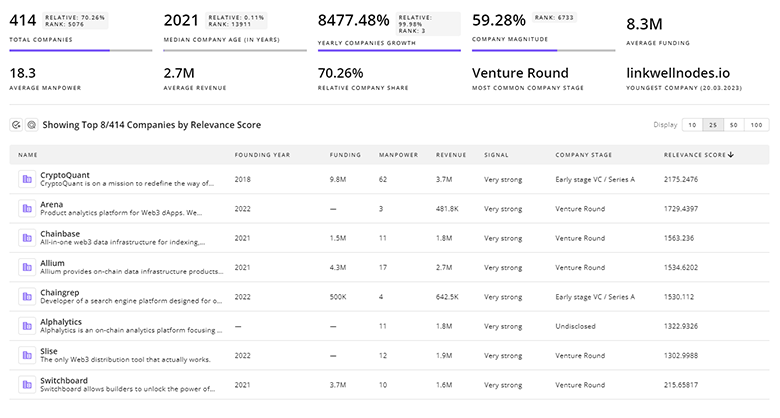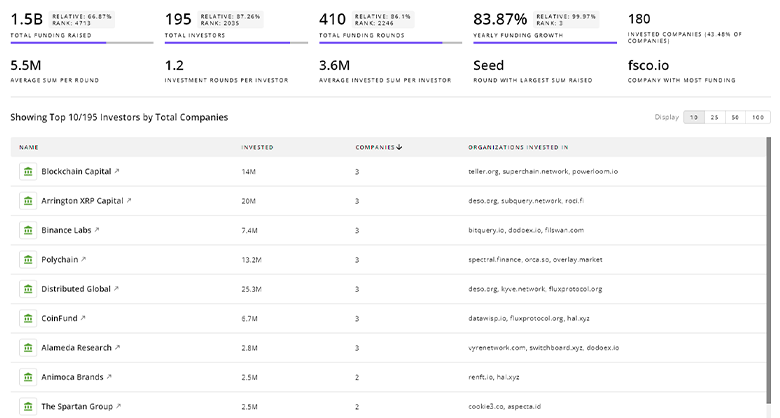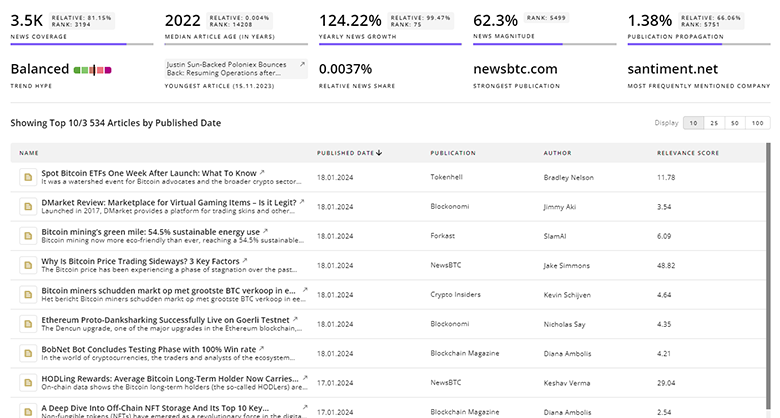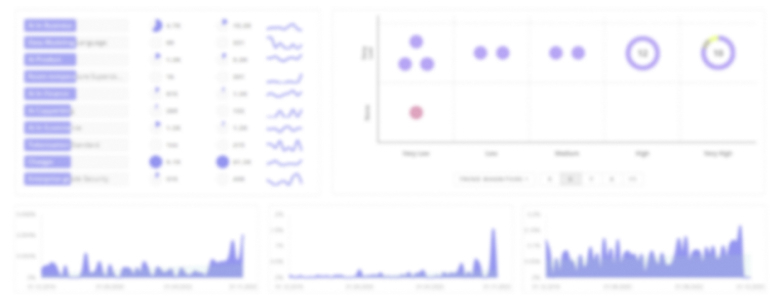
Operating System Report
: Analysis on the Market, Trends, and TechnologiesThe operating system market is shifting from monolithic general-purpose platforms to a fragmented set of highly specialised OS solutions driven by cloud, IoT, real-time control and AI integration; the internal trend data shows 6,023 companies addressing OS topics with total funding of $24.58B and 3,360 funding rounds to date, underscoring strong investment activity despite declining patent growth. Market forecasts quantify this opportunity: a base OS market of roughly US$59.24B in 2025 growing to US$91.64B by 2030 at a 9.12% CAGR, while IoT-specific OSs forecast far higher CAGR (40.4% to 2032), highlighting asymmetric growth pockets to prioritise Operating System Market – Forecasts from 2025 to 2030 Global Internet of Things (IoT) Operating Systems Market Size.
The last time we updated this report was 31 days ago. If there’s something missing or off, your tips are welcome!
Topic Dominance Index of Operating System
The Dominance Index for Operating System merges timelines of published articles, newly founded companies, and global search data to provide a comprehensive perspective into the topic.
Key Activities and Applications
- Cloud-native microservices and unikernels: lightweight OS variants (unikernels/microkernels) are being developed to reduce overhead and attack surface for micro-VMs and serverless workloads OSv IncludeOS.
- Industry vertical OSs: bespoke operating systems act as operational backbones in manufacturing, energy and 3D printing where domain logic and traceability are integrated at the OS level CompositeOS - The Operating System of the Composite Industry CarbonOS 3DPrinterOS.
- IoT and embedded RTOS: real-time determinism and minimal footprint for safety-critical devices remain core activities, serving automotive, robotics and industrial automation HIPPEROS S.A. SCIOPTA Systems AG.
- Automotive vehicle OS and AIOS: vehicle OSs evolving into AIOS that schedule compute across CPU/GPU/NPU for multimodal agents and on-device models, integrating SOA and agent frameworks for intent-driven experiences Automotive Operating System and AIOS Integration Research Report, 2025.
- Security, device attestation and hardware-secured OS: secure boot, remote attestation and lightweight secure OS variants for IoT devices are in demand to reduce cloning/forgery risk Security Platform Inc.
Emergent Trends and Core Insights
- Specialisation beats generalisation: patent and company signals show growth in vertical and function-specific OSs (energy, manufacturing, automotive, AI agent hosts), creating commercial niches where domain fit and certification matter more than broad market share.
- AI integration — three-phase path: OSs are moving from AI as app, to AI-driven middleware, to AI-native OS where models become first-class runtime elements used for scheduling, intent parsing and proactive resource allocation.
- Unikernel and microkernel adoption: for cloud and edge efficiency, smaller kernels and application-tailored OS builds reduce latency and resource use and are being commercialised by multiple projects OSv IncludeOS.
- Security and hardware trust: device-level secure OS with TPM/eSE-backed key stores and remote attestation are becoming product differentiators for IoT vendors.
- Regional and sectoral divergence: overall OS market growth is steady (9.12% CAGR), but IoT OS growth is explosive (40.4% CAGR), and automotive AI/vehicle OSs show accelerated local activity (notably China) where OEMs and suppliers rapidly adopt AI-native and SOA architectures Global and China Automotive Operating System (OS) Industry Report, 2023-2024.
Technologies and Methodologies
- Unikernels and microkernels: minimal OS layers replacing full kernels for single-purpose workloads, improving boot times and security OSv IncludeOS.
- Container, micro-VM and hypervisor stacks: virtualization and micro-VMs enable multi-OS consolidation and safe co-residency of workloads in centralised and vehicle platforms.
- AI runtimes embedded in OS: model inference and scheduling engines inside OS middleware to allocate CPU/GPU/NPU dynamically and support on-device foundation models.
- Memory-safe systems languages: Rust adoption for safety-critical OS components, especially in automotive and ECU contexts, to reduce memory errors OxidOS Automotive.
- Hardware-rooted security: TPM/eSE plus remote attestation servers as OS-integrated services for lifecycle device integrity and anticlone measures Security Platform Inc.
Operating System Funding
A total of 1.0K Operating System companies have received funding.
Overall, Operating System companies have raised $27.7B.
Companies within the Operating System domain have secured capital from 3.7K funding rounds.
The chart shows the funding trendline of Operating System companies over the last 5 years
Operating System Companies
- OSv: Open-source unikernel engineered for cloud workloads; optimises micro-VM performance and simplifies runtime for microservices, appealing to cloud-native infra teams seeking minimal OS overhead and faster VM boot times OSv.
- OSWARE: China-based provider of IoT OS platforms that accelerates time-to-market for smart product manufacturers by delivering packaged IoT kernels and middleware for device vendors focused on controlled delivery and local chip support OSWARE.
- HIPPEROS S.A.: Developer of Maestro RTOS for multicore safety-critical applications in vehicles and robotics; its kernel targets parallelism, determinism and safety certification needs for intelligent autonomy vendors HIPPEROS S.A..
- OxidOS Automotive: Building a Rust-based OS and toolchain for automotive ECUs; differentiates through memory safety and developer tooling aimed at reducing certification time for OEMs and tier-1 suppliers OxidOS Automotive.
- ForgeOS: Operating system designed to host and manage AI agents; focuses on agent lifecycle, observability and secure integration across messaging and voice channels — an example of OS-as-platform for the AI-agent use case ForgeOS.
Delve into the corporate landscape of Operating System with TrendFeedr’s Companies tool

6.7K Operating System Companies
Discover Operating System Companies, their Funding, Manpower, Revenues, Stages, and much more
Operating System Investors
TrendFeedr’s Investors tool provides insights into 4.9K Operating System investors for you to keep ahead of the curve. This resource is critical for analyzing investment activities, funding trends, and market potential within the Operating System industry.

4.9K Operating System Investors
Discover Operating System Investors, Funding Rounds, Invested Amounts, and Funding Growth
Operating System News
TrendFeedr’s News feature offers you access to 102.3K articles on Operating System. Stay informed about the latest trends, technologies, and market shifts to enhance your strategic planning and decision-making.

102.3K Operating System News Articles
Discover Latest Operating System Articles, News Magnitude, Publication Propagation, Yearly Growth, and Strongest Publications
Executive Summary
The operating system opportunity is no longer a single mass market but a mosaic of high-value niches. Investors and product teams should prioritise: (1) OSs that embed AI runtimes and scheduling (AI-native/middleware), because they unlock new UX and performance economics; (2) lightweight OS architectures (unikernel/microkernel) for cloud and edge to reduce cost and risk; (3) security-first OS designs with hardware attestation for IoT; and (4) vertical OS platforms that bundle domain-specific workflows (manufacturing, energy, automotive) to capture lock-in through integration and certification. Tactical choices depend on whether the priority is scale (server/mobile OS incumbents) or margin and defensibility (specialised, certified OSs). Data shows capital and developer energy concentrated in specialised OS segments and IoT/automotive verticals — these are where near-term commercial returns and strategic differentiation will most likely emerge.
Are you an insider in the trends or tech industry? We’d love for you to contribute to our content.











